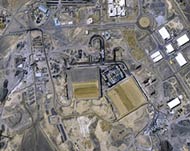Nuclear watchdog chief to visit Iran
United Nations nuclear watchdog chief Muhammad al-Baradai will visit Iran for talks on Thursday.

His visit comes two weeks before a deadline expires for the Islamic Republic to dispel US-led suspicions about its nuclear programme.
The International Atomic Energy Agency (IAEA), in a tough resolution last month, gave Iran until 31 October to prove it is not secretly trying to develop a nuclear weapons programme.
A spokesman for Iran’s Atomic Energy Organisation said on Monday al-Baradai would spend two or three days in Tehran.
Iranian cooperation
UN inspectors arrived in Iran two weeks ago. President Muhammad Khatami has said Tehran will provide whatever cooperation is needed to show its nuclear aims are limited to generating electricity.
“In terms of inspections, so far, we have been allowed to visit those sites to which we have requested access,” al-Baradai told Reuters on Monday.
But he added “no later than 31 October Iran must provide full and complete information on their nuclear programme. This task is certainly doable in this timeframe and really shouldn’t take more than a week or two”.
Al-Baradai has warned that if Tehran fails to cooperate fully Iran’s case may be sent to the UN Security Council for possible sanctions.
Western diplomats remain sceptical that Iran will do enough to enable the IAEA to give its nuclear programme a clean bill of health in its next report in November.
Arms-grade traces
Concerns about Iran’s nuclear programme were fuelled earlier this year when Tehran revealed it was well on the way to enriching uranium.
However, Iran says it needs to produce low-grade enriched uranium to use as fuel in nuclear power reactors. Highly enriched uranium can also be used to make atomic bombs.
 |
|
Satellite image shows a uranium |
The IAEA has found traces of arms-grade enriched uranium at two sites in Iran this year, but Tehran says this is due to contamination from machinery bought on the black market.
Al-Baradai said Tehran had so far provided some but not all of the information requested by the IAEA on the imported parts.
“The core issue for us is understanding the history and nature of Iran’s uranium enrichment programme. In particular we need to determine whether or not Iran has had nuclear activities which were not declared to the IAEA,” said al-Baradai.
More allegations
An Iranian opposition group that has provided accurate information in the past about undeclared Iranian atomic facilities claimed on Monday that Tehran had been hiding another nuclear facility from the IAEA.
An official from the exiled opposition group the National Council of Resistance of Iran said it had details of a secret facility in Iran and would provide details on Tuesday.
Khatami adviser Ali Rabai told the official IRNA news agency that Iran would start negotiations with the IAEA next week about signing the Additional Protocol to the nuclear Non-Proliferation Treaty. This would give IAEA inspectors virtually unfettered access to carry out snap checks.
“Political and security considerations will be prioritised in the talks,” Rabai said.